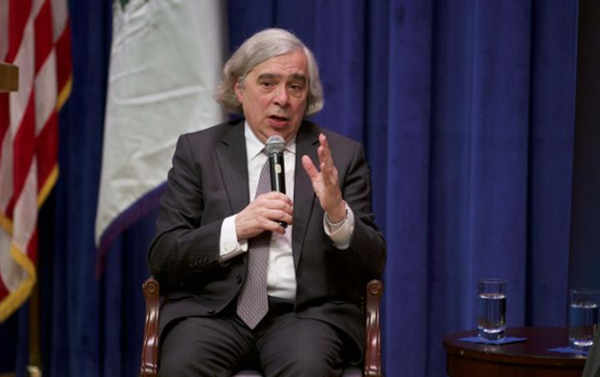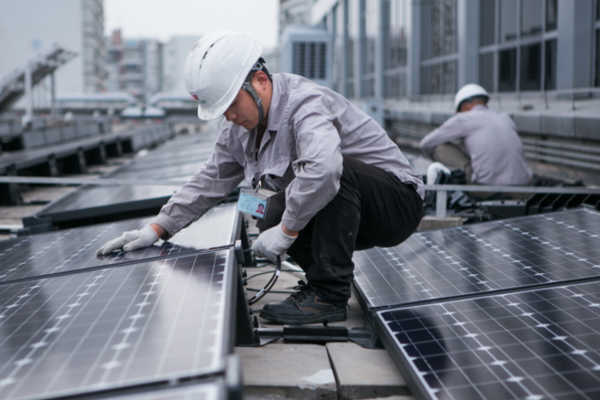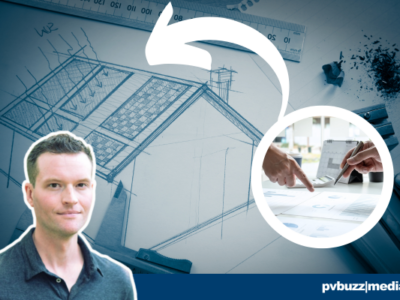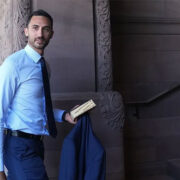Energy Secretary Ernest Moniz, Ph.D., joins the team at Direct Current to look back on the highs and lows of his time at the Energy Department, the progress we’ve made, and the challenges and opportunities still to come.
TRANSCRIPT: The Exit Interview
MATT DOZIER: Hello, and welcome to Direct Current. Episode 10!
ALLISON LANTERO: Yes! 10! A good round number to cap the first Season of the show. And we’re really excited to share this one with you. As always, I’m Allison LANTERO:…
DOZIER: …and I’m Matt DOZIER:, and with the current presidential administration coming to a close, we asked a very special guest to share some thoughts on his time here at the Energy Department.
ERNEST MONIZ: Who am I, and why am I here?
LANTERO: That’s right — it’s our boss, nuclear physicist and Secretary of Energy, Dr. Ernest MONIZ:.
MONIZ: I’m Ernie Moniz:, I’m U.S. Energy Secretary, the 13th in line, and presumably, that’s been a lucky number.
MONIZ: This is the last episode of Direct Current as the secretary leaves the building.
DOZIER: Yep. Secretary MONIZ: is running out the door and we’re trying to chase him with the microphone. (laughter)
LANTERO: (aside) We actually sat down with him in his office overlooking Independence Avenue, so you may hear some street noise in the background.
DOZIER: Sitting down with Secretary Ernest Moniz.
LANTERO: Thank you for being with us today, Sir.
MONIZ: It’s a pleasure.
LANTERO: We wanted to start off with asking, what was your best day on the job?
MONIZ: Well, it’s hard to pick a single best day, but certainly the day in which we signed the Iran Deal was pretty close to the top. Another one I have to say is when we had the announcement day in Paris of Mission Innovation, which put innovation in energy technology right at the middle of addressing climate change. So those were two high points, but you know, I think the real pleasure in the job is, day in and day out, really advancing what I just think is the preeminent science organization in the world and applying that to important problems. Certainly, in terms of singular days, those two would be hard to beat.
LANTERO: What about your hardest day?
MONIZ: Well, you know, we have our ups and downs, and certainly one occurred just about three years ago when we had the accidents at WIPP and we had to close for three years, and we’re pretty optimistic that we’re going to be cutting the ribbon on the reopening very shortly.
DOZIER: WIPP — that’s W-I-P-P — is the Waste Isolation Pilot Plant in New Mexico. It’s where we store nuclear waste from defense activities deep underground, and it actually reopened on January 9, 2017, after we recorded this interview.
MONIZ: So this is a very, very big day, and I have to say that our team did a fabulous job over the last months to get to this point.
DOZIER: What were your expectations coming into the job?
MONIZ: Well, you know, first of all, I did have more of a running start than most from the point of view of having been here previously in the Clinton Administration as undersecretary, so I knew pretty well the missions of the department, the laboratories, but being here now, I guess 12 years after I left, the opportunities were much greater partly because I really was fortunate to be here at a time when the president exercised very successfully personal leadership on two of his priorities internationally. One was on climate change and the energy innovation solutions for climate change, and secondly was nuclear security. Of course, he put forward the Prague Agenda, so-called, in 2009 and then had a series of nuclear security summits. This completely elevated the posture for addressing non-proliferation among roughly 50 countries. So you know, those are two areas right in the sweet spot of this department, and so being able to work with my colleagues here, colleagues across the government in many cases, on those two really high priorities of the president was just an extraordinary opportunity, and I’ve got to say, DOE delivered.
DOZIER: So you already knew what to expect in a sense, going in, right?
MONIZ: Yeah, again, so I knew basically what our missions were. I didn’t come in here with expectations of a more focused department. I knew we did science, very very critically, we did energy, we do nuclear deterrents, we do nuclear nonproliferation, we clean up from the Cold War, we do all that, but of course I also understood how the department at its core is a science and technology organization. What was great to see was the opportunity now to really elevate in many ways the view of — and in some sense, the performance of — the National Laboratories.
LANTERO: You’ve mentioned some already, but where would you say we’ve made the most progress during your time as the Secretary of Energy?
MONIZ: Well, first of all, there’s the programmatic progress, and certainly if I take energy, the progress in working with other partners in the private sector, that the progress of driving down the costs of clean energy has been really, really incredible. The most extreme, in a certain sense, LED lighting with a 94 percent reduction in costs in the last 7-8 years, is pretty spectacular. Of course, the driving innovation, as I said earlier, to the center of the climate response internationally was I think again very, very important progress that will be sustained in the years forward.
In science, we’ve continued, I think, a critical role, which is to continue designing, building and operating facilities that are at the cutting edge — light sources, neutron sources, accelerators — that serve over 30,000 American scientists every year at the cutting edge. And indeed, while it may not be the most important factoid, it is nevertheless an interesting one that those facilities served as the foundation for six Nobel prizes in physics and chemistry that were awarded during this president’s administration. There are a lot more — there’s over 100 during the history of the department — but just in these years, it gives you an idea what those facilities mean to the country’s researchers.
Another area is the progress that we’ve continued to make in high-performance computing. We’ve been the leaders for decades. We continue that. We are on the march to what’s called “exascale” — 10 to the 18th operations per second — but even more important, in my view, is we are now launching into a new arena where it’s not just how fast is the machine, it’s how does the machine handle enormous databases of the kind we are dealing with today. How do we get the machines to learn themselves where to go and find the right data, to put them together? That’s going to serve our traditional missions in the weapons program, in climate science and across the board — but not well-known to the public yet. That’s also the foundation of what we are doing at the center of the Cancer Moonshot project, and we have been sought out by the vice president, but also by the head of the Cancer Institute, by the head of Veterans Affairs, for partnerships, and in fact, a great milestone was reached only a few weeks ago when an enormous database — I mean enormous database — was delivered to one of our laboratories to start the work with Veterans Affairs on understanding cancer, and we expect that’s going to save veterans’ lives. This department does a lot incredible things.
So far, I’ve only covered energy and science. Then in nuclear security, in terms of the progress, very important progress is the continuation of our science-based stockpile stewardship program, which means that even as we shrink our nuclear weapons stockpile — and we have been doing so — we continue to be able to certify every year to the president — and frankly, I have just signed off for this year — on the safety, security and effectiveness of the deterrent without nuclear testing. That is extremely important, particularly when I add the “without testing.” It’s been since 1992 since we tested, and these… they get older and older, but we get better and better in terms of understanding the science and being able to sustain them in a way that gives our national security posture, really, its foundation. But beyond that, we have as part of the president’s Prague Agenda, we have removed high-enriched uranium and plutonium from 14 countries — enough for about 160 nuclear weapons, if it fell into the wrong hands. We’ve got whole regions — South America, southeast Asia — that have become totally free of these materials.
I should have mentioned Iran, of course. Another thing on nuclear security was, of course, the Iran negotiation, and I think that certainly the scientific community — it was expressed again in a letter that they sent to the president-elect on Monday, just two days ago. They sent a letter reinforcing how the agreement breaks completely new ground in nonproliferation, verification and transparency, with novel features that I’ll be honest, I would love to see eventually become part of the broader safeguards approach that IAEA can take internationally. That was a big step forward, and frankly, once again, I go back to the theme: unknown for most of the negotiation, at least, seven of our National Laboratories and two of our nuclear sites were essential in providing the analytical work that underpinned the American and Western — P5 plus 1 — negotiating posture. I should perhaps explain, P5 are the permanent members of the Security Council, and the plus 1 is Germany.
Another one that we don’t talk about enough — and I wish there were just another couple months for this one at least — and that is that working with the Navy, it’s a joint program, we have designed new nuclear reactors to power the next-generation aircraft carrier. It’s called the Ford class, named after President Gerald Ford, and that first Ford-class aircraft carrier will be on the water in a couple of months. That’s a big step forward there, as well.
Again, you can tell I’m very enthusiastic about the work that we do here, the people we have doing it — it’s just terrific. And I’ll say it again, because I never get tired of it: it’s a science and technology powerhouse serving the American people in critical missions.
DOZIER: You mentioned earlier the Paris Climate Summit. Talking about the progress we’ve made, especially with clean energy solutions — is all this progress going to last?
MONIZ: Absolutely. I think the first thing is to emphasize that, certainly in my view, there’s no going back. There may be bumps in the road in various places, but after Paris, with every country in the world committing to a low-carbon trajectory, at least into the 2025-2030 timeframe, there’s no going back. We are heading to a low-carbon world. We need to participate in that very, very aggressively and actively, not just because we — and President Obama, certainly, has been a leader in getting us to the place that we are at, working with China and other major economies — but also because innovation here is going to be critical, and we are talking, frankly about a multitrillion-dollar clean energy opportunity globally. In fact, not so long ago, an arm of the World Bank, the International Finance Corporation, estimated that just in 21 emerging economies, there would be a $23 trillion opportunity to 2030, just in those countries. So, we want to innovate, and we want to stay ahead of that, and we want to get our share of that market even as we transform our own economy.
Finally, I would add to that, businessmen, I would say, also understand — largely, at least — that we’re not going back, that if you look not just one year, but if you look 10 years, and 20 years and 30 years down the road, we’re going to be going to a low-carbon economy. Well those businessmen are often being called upon to make billion-dollar-scale capital commitments for projects that last on a maybe five years to 10 years and then run for decades beyond that. I think a chief risk officer of a corporation would not be doing a very good job to suggest laying out billions of dollars right now betting on a high-carbon world, in the future. So I think that this is the direction we’re going. We have a lot of the tools we need right now in terms of clean-energy technology certainly to get us to our Paris goals. For the United States, that’s in 2025. I think we’re on track for meeting our goals in 2020 and 2025. But if you start talking about the “deep decarbonization” that’s going to be called for beyond that, going out to midcentury, we’ve got a lot of innovating left to do.
In fact, what I would say is the biggest progress we’ve made in terms of lower carbon has been in the electricity sector, and that’s a combination of natural gas substituting for coal because of the market dynamics, and the rapid growth of renewables, especially wind and now solar, coming up. But to get to deep decarbonization, we’ve got to complete that job in the power sector, but we also have to do transportation, we also have to do industry, and this is challenging. We need to both push the deployment and the continued cost reduction of what we’re working with now while at the same time, we research some of the very fundamental science problems that will allow bigger breakthroughs for deep decarbonization down the road. This department is right in the thick of that. In fact, we will be putting out not long from now, just over a week, probably, we will be putting out a portfolio that maps out in general terms how we would use a doubling of the energy R&D budget to meet those kinds of long-term goals for the environment, for the economy, and for security.
LANTERO: For better or worse, people tend to recognize you for your hair. Are you surprised by the amount of attention your hair has gotten?
MONIZ: I had a period of surprise. I’ve gotten over it. I think they have too (laughs). But when you’ve been living with it for many, many decades, like five, you don’t think about it. But apparently others did. I think we’re all past that phase.
(laughter)
DOZIER: You said earlier that this is your second time leaving the Energy Department. You have a lot of perspective from not just the past 3 ½ years, but from your previous time at the agency. How does the feeling of stepping down now compare to the last time?
MONIZ: Well, I can assure you, in both times it was my assumption that that was the end of my public service. I think that it apparently was incorrect the first time — I do believe it will be correct this time.
But look, the jobs are different. As undersecretary, I really enjoyed tremendously my time here. I might add that at that time, when I came here the first time, there was only one undersecretary, so I did actually have reach, if you like, across the entire department, which has been very helpful in my new role.
Now, as secretary, obviously it’s a little bit different, but what I really appreciate is that it gave me the chance to really put together the senior staffing of the department, both those who are confirmed by the Senate and those who work as my direct advisors and colleagues. I have to say that I think this team is absolutely outstanding — I may not be fully objective, but I think by far the best team that has had overall — because of the depth of the talent. So now, going back to your question, in leaving, it’s bittersweet in the sense of seeing this team, obviously, break up, in a sense. Now we’re hopefully we’re all going to be working on issues like climate, like nuclear security, and we’ll probably be staying in touch, but it’s different to be doing things, you know, individually or with small groups as opposed to a team that we can talk with every morning in our morning meeting and talk about where we’re going. That day, that week, that month, that year. It’ll be different, but I’ve always believed that you just look for the next adventure.
I have to say, something that is hard for me now to see how I will maintain the streak in which I could claim that every job I had was the best one I’d had. This may be tough to top.
LANTERO: So, to cap it off, after all the wonderful experience you’ve had here, what advice do you want to give your successor?
MONIZ: Well, the first part of my advice is, obviously each person will have a different style, a different way of approaching the management of the department, but I think the common elements are to recognize that again, this department — its strength, its distinctiveness among the cabinet agencies is its core of science and technology just permeating all the missions. So I think that has to be appreciated.
I want to make it clear, that does not mean you have to be a scientist to manage the department successfully. I have to say, for me personally, because that’s who I am, I was able to use that background rather consistently, but you have to put a team together as I have — my team is not composed all of scientists. You need different skill sets. But I think the next secretary certainly needs to really internalize how science and technology gives this department a distinct flavor, how the 17 National Laboratories are in many ways our essential assets for applying science and technology to our problems.
Use the lab directors in a strategic role, because they’re out there, they’re close to the science and technology. The laboratories are the ones who do the science and technology, and they work out, really, how you should go about solving those problems — but in turn, using them as strategic assets for thinking about the directions that we want to go in with our research portfolio. So I think those are some keys to success in getting the best out of DOE, no matter who the secretary is.
DOZIER: So I have one final, very important question, which is: What is the airspeed velocity of an unladen swallow?
MONIZ: European or African?
LANTERO: How do you know so much about swallows?
(laughter)
DOZIER: Aaaaahhh….
MONIZ: And I would say, about 11 meters per second.
DOZIER: Spot on, according to our background research.
MONIZ: European.
DOZIER: European, of course. Well, thank you, Secretary MONIZ:, for being here with us.
MONIZ: You’re most welcome.
LANTERO: Yes, thank you so much.
MONIZ: Terrific. OK, thank you.
(Music plays)
DOZIER: Once again, we’d like to thank Ernest MONIZ:, the Energy Department’s preeminent nuclear physicist and Monty Python enthusiast, for joining us on the podcast.
LANTERO: And of course, thank you to everyone who has listened to the show over the past eight months. We hope you’ve enjoyed it as much as we’ve enjoyed making it.
DOZIER: That wraps it up for Season 1 of Direct Current! We’ll be back with more great energy stories, so stay tuned for details about future episodes. If you missed any of the shows from this season, you can find them all on iTunes or on our website at energy.gov/podcast.
LANTERO: If you have questions or comments or ideas for stories you’d like to hear, you can email us at [email protected] or tweet @ENERGY.
LANTERO: Direct Current is produced by Matt DOZIER:, Simon Edelman and me, Allison LANTERO:. With Producer Pat Adams, Art and design by Cort Kreer. Support from Paul Lester, Daniel Wood, Atiq Warraich and Ernie Ambrose.
DOZIER: Thanks to John LaRue, Amy Phillips Burch, and the Energy Public Affairs Team, and to Kevin Fitzmaurice, Ryan Robinson, Val Battle, Francie Harris and everyone in the Secretary’s office for helping arrange this interview.
LANTERO: This show would not be possible without the support of Aofie McCarthy, Eben Burnhum-Snyder, and especially our boss Marissa Newhall. Thank you all so much.
DOZIER: We’re a production of the Department of Energy and published from our nation’s capitol in Washington, D.C.
LANTERO: Until next time, thanks for listening!
(END)


















Comments